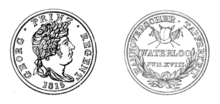Hanoverian Waterloo Medal

The Hanoverian Waterloo Medal was issued to all members of the Hanoverian army who fought in the battles of Quatre Bras and Waterloo 16–18 June 1815.[lower-alpha 1]
History
The Hanoverian Waterloo Medal, like the British Waterloo Medal, has a profile and laureate head of the Prince Regent to the right, with the legend GEORG. PRINZ. REGENT, 1815, round it.[1]
On the reverse are two branches of laurel and a breastplate, with two spears and two colours crossed on either side; underneath is the date, WATERLOO JUN. XVIII., and, above, in Roman letters, HANNOVER SCHER TAPFERKEIT. Round the rim are the soldier's name, regiment, etc.[2]
This medal was founded by George, the Prince Regent in December 1817, and was awarded to every soldier who was present in the Hanoverian army at the Battle of Waterloo. It is suspended by a crimson ribbon with light blue borders, and the owner was permitted to wear this ribbon without the medal, contrary to the rule which prevailed in Britain.[3]
Unlike also the custom in Britain at the time it was issued, the medal remained the property of the soldier, and if he left the military service, he was still allowed to wear it. It could not, however, under any circumstances, be transferred from one soldier to another, but after the death of the first recipient of it, it was ordered that it should remain in his family as an heirloom. The Hanoverian troops present on the 16th, 17th, and 18th of June at Battle of Quatre Bras and Waterloo, under the command of General Charles Alten, consisted of nearly 25,000 men, of whom about 2,000 were put hors de combat.[3]
Other Waterloo medals
Five nations of Seventh Coalition struck medals for soldiers who took part in the campaign:[4]
- British Waterloo Medal (British Army and King's German Legion)
- Brunswick Waterloo Medal
- Hanoverian Waterloo Medal
- Nassau Waterloo Medal
- Prussian Waterloo Medal
Gallery
-

The medal with ribbon
-
Front
-
Reverse
-
Edge
-
Ribbon
Notes
- ↑ Royal Numismatic Society 1869, p. 112.
- ↑ Royal Numismatic Society 1869, pp. 112–113.
- 1 2 Royal Numismatic Society 1869, p. 113.
- ↑ Royal Numismatic Society 1869, p. 109.
- ↑ Chichester 1893, p. 347.
References
-
 Chichester, Henry Manners (1893). "Lyon, James Frederick". In Lee, Sidney. Dictionary of National Biography. 34. London: Smith, Elder & Co. p. 347.
Chichester, Henry Manners (1893). "Lyon, James Frederick". In Lee, Sidney. Dictionary of National Biography. 34. London: Smith, Elder & Co. p. 347. - Royal Numismatic Society (1869). "The Hanoverian Waterloo Medal". The Numismatic Chronicle. 9. Royal Numismatic Society (Great Britain).